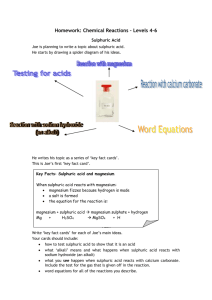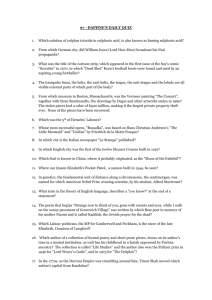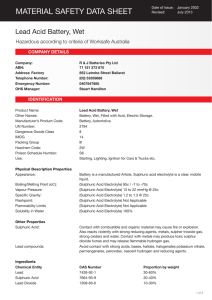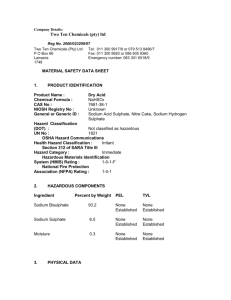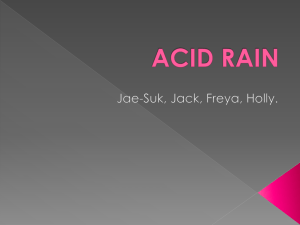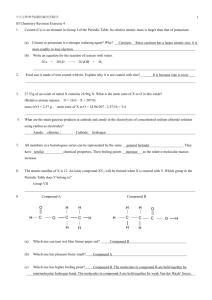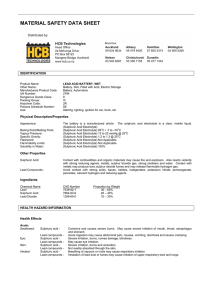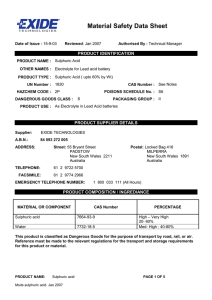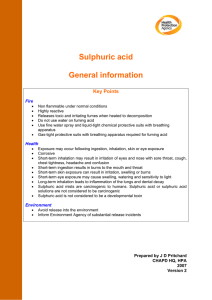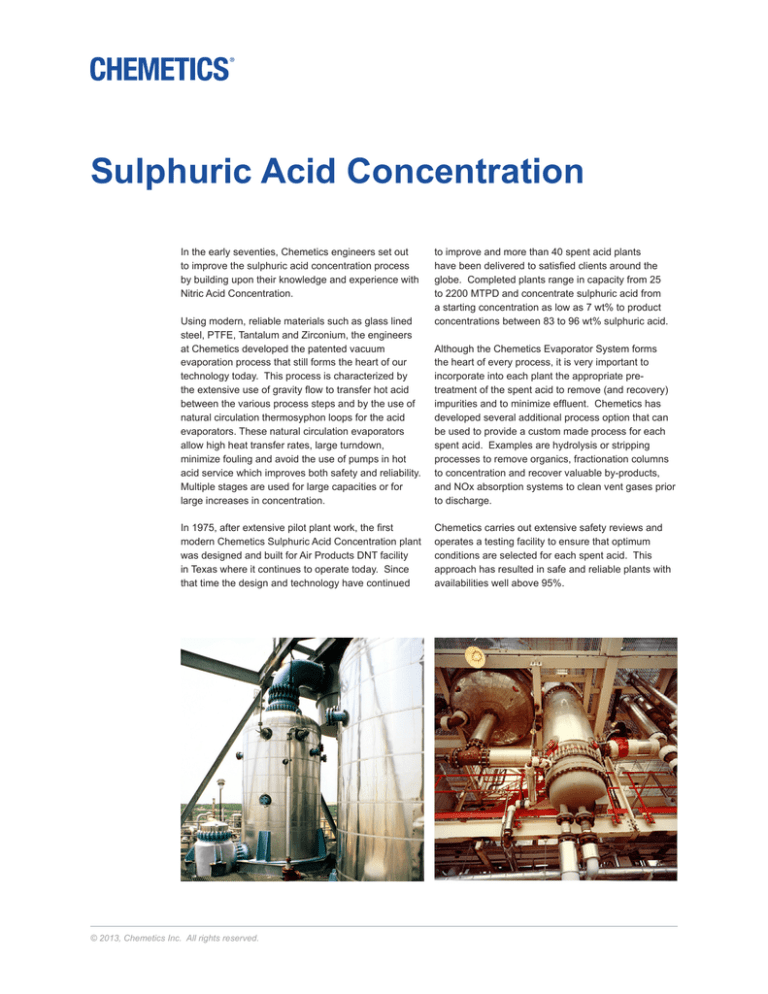
Sulphuric Acid Concentration
In the early seventies, Chemetics engineers set out
to improve the sulphuric acid concentration process
by building upon their knowledge and experience with
Nitric Acid Concentration.
Using modern, reliable materials such as glass lined
steel, PTFE, Tantalum and Zirconium, the engineers
at Chemetics developed the patented vacuum
evaporation process that still forms the heart of our
technology today. This process is characterized by
the extensive use of gravity flow to transfer hot acid
between the various process steps and by the use of
natural circulation thermosyphon loops for the acid
evaporators. These natural circulation evaporators
allow high heat transfer rates, large turndown,
minimize fouling and avoid the use of pumps in hot
acid service which improves both safety and reliability.
Multiple stages are used for large capacities or for
large increases in concentration.
In 1975, after extensive pilot plant work, the first
modern Chemetics Sulphuric Acid Concentration plant
was designed and built for Air Products DNT facility
in Texas where it continues to operate today. Since
that time the design and technology have continued
© 2013, Chemetics Inc. All rights reserved.
to improve and more than 40 spent acid plants
have been delivered to satisfied clients around the
globe. Completed plants range in capacity from 25
to 2200 MTPD and concentrate sulphuric acid from
a starting concentration as low as 7 wt% to product
concentrations between 83 to 96 wt% sulphuric acid.
Although the Chemetics Evaporator System forms
the heart of every process, it is very important to
incorporate into each plant the appropriate pretreatment of the spent acid to remove (and recovery)
impurities and to minimize effluent. Chemetics has
developed several additional process option that can
be used to provide a custom made process for each
spent acid. Examples are hydrolysis or stripping
processes to remove organics, fractionation columns
to concentration and recover valuable by-products,
and NOx absorption systems to clean vent gases prior
to discharge.
Chemetics carries out extensive safety reviews and
operates a testing facility to ensure that optimum
conditions are selected for each spent acid. This
approach has resulted in safe and reliable plants with
availabilities well above 95%.
Sulphuric Acid Concentration Background
The concentration of Sulphuric acid provides a number
of technical challenges/choices that must be carefully
managed in order to create an economic and reliable
process.
Sulphuric acid can be concentrated by boiling the
solutions as water evaporates preferentially. The
graph below shows the atmospheric boiling point of
sulphuric acid at various concentrations:
It is clear that high temperatures are required to obtain
concentrated acid. When the required temperature
exceeds the temperature of the available heat source
(normally steam) and /or the temperature limits
(approximately 200°C) of the available materials
of construction, it is necessary to carry out the
concentration under vacuum. The vacuum levels
used in practice are further constraint by the desire
to condense the water that has been removed using
normal cooling water resulting in a practical lower
operating limit of approximately 100 mBara.
As can be seen below, using 10 Barg steam it is
possible to concentrate up to ~85 wt% at an operating
pressure of 100 mBara. If 20 Barg steam is used,
the maximum possible concentration at 100 mBara
pressure increases to ~90 wt%. For even higher
concentrations it is necessary to operate at a lower
pressure and the use of chilled water to condense the
overhead vapours is required.
At high concentrations a further complicating factor
comes into play. As the acid concentration increases,
the vapours removed from the boiling liquid consist not
only of water vapour, but also contain an increasing
amount of sulphuric acid vapour. The sulphuric acid
vapour concentration increases until the azeotrope is
reached at ~98.3 wt% H2SO4. The acid concentration
in the vapour is shown in the graph below:
Based on this graph it can be concluded that acid
concentrations up to approximately 89wt% are
possible with acceptable (<2.5 wt%) acid losses to the
overhead and no special precautions have to be taken
to prevent corrosion of the overheads condensing
system or recover the acid lost from the system.
At higher concentrations additional process equipment
is required to remove and recover the sulphuric acid
from the evaporator overheads. Generally a packed
column is used to contact the vapours with a dilute
sulphuric acid liquid stream. This causes the sulphuric
acid vapours to be selectively removed after which
the water vapour can be condensed in the overheads
condensing system.
Due to the presence of the azeotrope at 98.3 wt%
H2SO4 concentration it is not practical to concentrate
to a product concentration that exceeds 97wt% H2SO4.
If a higher concentration is required, it is possible to
fortify the acid further using either SO3 gas or Oleum.
Chemetics has over 40 years experience
concentrating sulphuric acid from a wide range
of sources. Around the world, acid concentrators
designed by Chemetics concentrate sulphuric acid
from starting concentrations as low as 10 wt% to
product concentrations exceeding 96 wt% – we are
ready to apply our knowledge and experience to meet
any sulphuric acid concentration requirements.
Chemetics Inc.
Suite 200 – 2930 Virtual Way
Vancouver, British Columbia, Canada V5M 0A5
© 2013, Chemetics Inc. All rights reserved.
Phone: +1 604 734 1200
Fax: +1 604 734 0340
Email: spent.acid@jacobs.com
www.jacobs.com/chemetics

